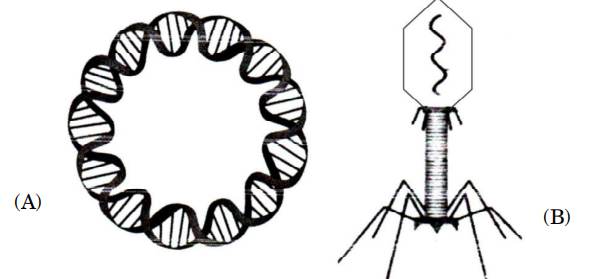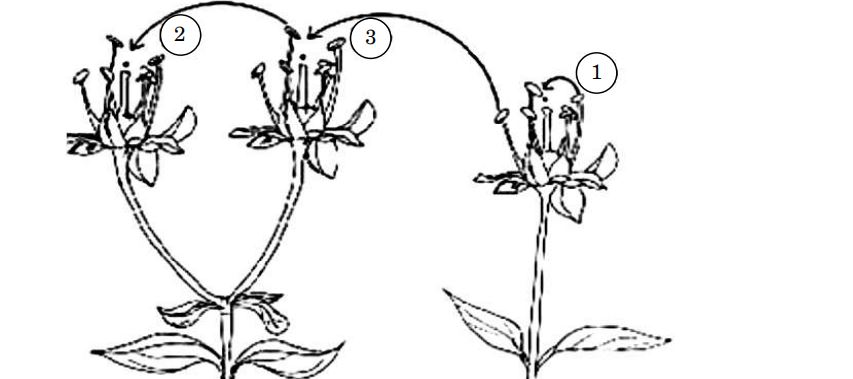CBSE Class 12 Biology Most Repeated Questions: As the CBSE Class 12 Biology board exam approaches, students are gearing up to revise all key areas and excel in the exam. Practising repeated questions serves as a strategic approach to reinforce key concepts and improve problem-solving skills. As CBSE often repeats questions in board exams directly or indirectly, revisiting frequently asked questions ensures that students are well-prepared to tackle any challenge that may arise in the examination hall.
In CBSE Class 12 Biology Exam 2024, questions will be distributed in the following pattern:
- Section A will have 16 questions of 1 mark each.
- Section B will have 5 questions of 2 marks each.
- Section C will have 7 questions of 3 marks each.
- Section D will have 2 case-based questions of 4 marks each.
- Section E will have 3 questions of 5 marks each.
Students can practise questions of all these formats from the set provided below.
CBSE Class 12 Biology Most Repeated Questions
1 Mark Questions
1.Which one of the following processes results in the production of
recombinants in future generations ?
(i) Mutation (ii) Independent assortment during meiosis I
(iii) Independent assortment during meiosis II (iv) Crossing over of bivalents
(a) (iv) only (b) (ii) and (iv)
(c) (i), (ii) and (iii) (d) (i), (ii), (iii) and (iv)
2.Study the DNA profiles obtained as a result of DNA fingerprinting of a
child 'X' and three individuals 1, 2 and 3. Which one of the following options shows the possible parents of the child 'X'?
Child Individual Individual Individual
(a) 1 and 2
(b) 2 and 3
(c) 1 and 3
(d) Only individual 3
3.The organism used in construction of the first artificial recombinant DNA by Cohen and Boyer in 1972 was :
(a) E. coli (b) Salmonella typhimurium
(c) Agrobacterium tumefaciens (d) Bacillus thuringiensis
Select the correct answer to these
questions from the codes (a), (b), (c) and (d) as given below. (a) Both Assertion (A) and Reason (R) are true and Reason (R) is the correct explanation of the Assertion (A).
(b) Both Assertion (A) and Reason (R) are true, but Reason (R) is not
the correct explanation of the Assertion (A).
(c) Assertion (A) is true, but Reason (R) is false.
(d) Assertion (A) is false, but Reason (R) is true.
4.Assertion (A) : A patient of ADA deficiency undergoing treatment for gene therapy requires periodic infusion of genetically engineered lymphocytes.
Reason (R) : Lymphocytes are immortal.
5.Assertion (A) : A cattle egret and grazing cattle in close association is a classic example of commensalism.
Reason (R) : As grazing cattle move through the field, they stir up and flush out insects from the vegetation that otherwise might be difficult for egrets to find and catch.
6.Mention two functions of codon AUG.
7.What is economic value of Spirulina?
8.Name the organism commercially used for the production of single cell protein.
9.Write full form of ELISA.
CBSE Class 12 Biology Sample Paper for Board Exam 2024
CBSE Class 12 Biology Additional Practice Questions for Board Exam 2024
2 Marks Questions
1.(i) Identify and name the structures 'A' and 'B' marked in the image given below:

(ii) State their importance in various biotechnology experiments.
2.A human being suffering from Down’s syndrome show trisomy of 21st chromosome. Mention the cause of this chromosomal abnormality.
3.In a dihybrid cross, when would the proportion of the parental gene combinations be much higher than non-parental type as experimentally shown by Morgan and his group.
4.A tall Pea plant with yellow seeds (heterozygous for both) is crossed with a dwarf Pea plant with green seeds. Using a Punnet square work out the cross to show the phenotypes and the genotypes of F1 generation.
5.The length of a DNA molecule in a typical mammalian cell is calculated to be approximately 2.2 meters. How is the packaging of this long molecule done to accommodate it within the nucleus of the cell.
6.Name any two vertebrate body parts that are homologous to human fore-limbs.
7.Name the type of human cell HIV attacks at its entry into the body. Explain the events that occur in the cell which further lead to cause immunodeficiency syndrome.
8.Name one plant and the addictive drug extracted from its latex. How does this drug affect the human body?
9.Why is Rhizobium categorized as a ‘symbiotic”?
10.Biotechnologists refer to Agrobacterium tumefaciens as a natural genetic engineer of plants. Give reason to support the statement.
11.Expand the name of enzyme ADA. Why is the enzyme essential in the human body? Suggest a gene therapy for its deficiency.
12.Mention any two significant roles predation play in nature.
3 Marks Questions
1.(a) (i) Expand the abbreviations given below, used for different modes of assisted reproductive technologies :
(1) ZIFT (2) ICSI (3) IUT (4) GIFT
(ii) Which one of them cannot be considered as a procedure of IVF? Give reasons in support of your answer.
2.(b) Differentiate between the following :
(i) Perisperm and Pericarp
(ii) Syncarpous pistil and Apocarpous pistil
(iii) Plumule and Radicle
3.(a) Expand IUD (b) Why is hormone releasing IUD considered a good contraceptive to space children?
4.Explain the zygote intrafallopian transfer technique (ZIFT). How is intrauterine transfer technique (IUT) different from it?
5.Q.37 Give reasons why (i) Most zygotes in angiosperms divide only after certain amount of endosperm is formed. (ii) Groundnut seeds are exalbuminous and Caster seeds are albuminous. (iii) Micropyle remains as a small pore in the seed coat of a seed. (iv) Integuments of an ovule harden and the water content is highly reduced as the seed matures. (v) Apple and Cashew are not called true fruits.
6.A snapdragon plant homozygous for red flower when crossed with a white flowered plant of the same species produced pink flowers in F1 generation. (a) What is this phenotypic expression called? (b) Work out the cross to show the F2 generation when F1 was self-pollinated. Give the phenotypic and genotypic ratios of F2 generation. (c) How do you compare the F2 phenotypic and genotypic ratios with those of Mendelian monohybrid F2 ratios?
7.(a) Construct a complete transcription unit with promoter and terminator on the basis of hypothetical template strand given below :
(b) Write the RNA strand transcribed from the above transcription unit along with its polarity.
8.How does industrial melanism support Darwin’s theory of Natural Selection? Explain.
9.(a) Natural Selection operates when nature selects for fitness. Explain. (b) The rate of appearance of new forms is linked to the life span of an organism. Explain with the help of a suitable example.
10.List the specific symptoms of pneumonia. Name the causative organism.
11.(a) Why do farmers prefer biofertilizers to chemical fertilizers these days? Explain. (b) How do Anabaena and mycorrhiza act as biofertilisers?
12.EcoRI is used to cut a segment of foreign DNA and that of a vector DNA to form a recombinant DNA. Show with the help of schematic diagrams.
(i) The set of palindromic nucleotide sequence of base pairs the EcoRI will recognize in both the DNA segments. Mark the site at which EcoRI will act and cut both the segments.
(ii) Sticky end formed on both the segments where the two DNA and foreign DNA join later to form a recombinant DNA.
13.Name the interaction in each of the following:
(i) Cuscuta and Shoeflower (ii) Orchid growing on Mango tree. (iii) Whale and Barnacle growing on its back.
4.Differentiate between the following interspecific interactions in a population (i) Mutualism and competition (ii) Commensalism and amensalism
5 Marks Questions
1.Meselson and Stahl carried out an experiment to prove the nature of
DNA replication. Recall the experiment and answer the following questions.
(i) Which two types of nitrogen were used by them in their experiment and why ?
(ii) Why did they take samples of E. coli at definite time intervals for their observation ?
(iii) State the role of caesium chloride density gradient in their experiment.
(iv) Write the conclusions they arrived at.
2.(i) What is the chemical name of smack? Why is the consumption of smack considered as an abuse?
(ii) Name the source plant and one effect of the following drugs on the human body:
(1) Marijuana (2) Cocaine (3)Morphine
3.(a) Study the diagram given below showing the modes of pollination. Answer the questions that follow.
(i) The given diagram shows three methods of pollen transfer in plants. What are the technical terms used for pollen transfer methods 1, 2 and 3?
(ii) How do the following plants achieve pollination successfully?
(1) Water lily (2) Vallisneria (iii) Flowering plants have developed many devices to avoid inbreeding depression. Explain one hereditary and one physiological device which helps plants to achieve this target.
4.(a) When and where does spermatogenesis occur in a human male?
(b) Draw a diagram of a mature human male gamete. Label the following parts : acrosome, nucleus, middle piece, tail.
(c) Mention the function of acrosome and middle piece.
5.(a) Draw a schematic representation of a transcription unit and show the following in it. (i) Direction in which the transcription occurs (ii) Polarity of the two strands involved (iii) Template strand (iv) Terminator (b) Mention the function of promoter in transcription.
6.Answer the following questions based on Meselson and Stahl’s Experiment. (a) Why did the scientists use 15NH4CI and 14NH4CI as sources of nitrogen in the culture medium for growing E.Coli.? (b) Name the molecule(s) that 15N got incorporated into. (c) How did they distinguish between 15N labeled molecules from 14N ones? (d) Mention the significance of taking E.coli samples at definite intervals for observations. (e) Write the observations made by them from the samples taken at the end of 20 minutes and 40 minutes respectively. (f) Write the conclusion drawn by them at the end of their experiment.
7.(a)Explain Darwinian theory of evolution with the help of one suitable example. State the two key concept of the theory. (b) Mention any three characteristics of Neanderthal man that lived in near east and central Asia.
8.(i) Write the scientific names of the two species of filarial worms causing filariasis. (ii) How do they affect the body of infected persons? (iii) How does the disease spread?
9.(i) Name the two type of lymphocytes involved in the specific immune system. (ii) Mention the two types of specific immunity they generate. (iii) Why is specific immunity considered to be unique in its function? Write any three special features of it.
10.(i) Describe the characteristics a cloning vector must possess. (ii) Why DNA cannot passs through cell membrane? Explain. How is a bacterial cell made competent to take up recombinant DNA from the medium.
11.(a) Name the source from which insulin was extracted earlier. Why is this insulin no more in use by diabetic people? (b) Explain the process of synthesis of insulin by Eli Lilly company. Name the technique used by the company. (c) How is insulin produced by human body different from the insulin produced by the above mentioned company.
Also check:
CBSE Class 12 Biology Syllabus 2023-24



Comments
All Comments (0)
Join the conversation